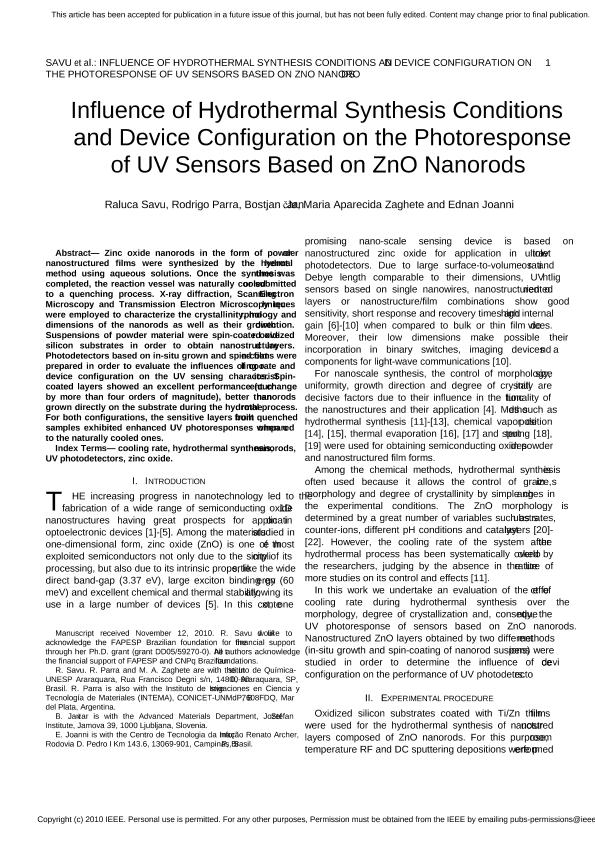Artículo
Influence of hydrothermal synthesis conditions and device configuration on the photoresponse of UV sensors based on ZnO nanorods
Fecha de publicación:
10/01/2011
Editorial:
Institute Of Electrical And Electronics Engineers
Revista:
Ieee Sensors Journal
ISSN:
1530-437X
Idioma:
Inglés
Tipo de recurso:
Artículo publicado
Clasificación temática:
Resumen
Zinc oxide nanorods in the form of powder or nanostructured films were synthesized by the hydrothermal method using aqueous solutions. Once the synthesis time was completed, the reaction vessel was naturally cooled or submitted to a quenching process. X-ray diffraction, Scanning Electron Microscopy and Transmission Electron Microscopy techniques were employed to characterize the crystallinity, morphology and dimensions of the nanorods as well as their growth direction. Suspensions of powder material were spin-coated over oxidized silicon substrates in order to obtain nanostructured layers. Photodetectors based on in-situ grown and spin-coated films were prepared in order to evaluate the influences of cooling rate and device configuration on the UV sensing characteristics. Spincoated layers showed an excellent performance (current change by more than four orders of magnitude), better than nanorods grown directly on the substrate during the hydrothermal process. For both configurations, the sensitive layers built from quenched samples exhibited enhanced UV photoresponses when compared to the naturally cooled ones.
Palabras clave:
Zno
,
Uv Photodetectors
,
Hydrothermal Synthesis
,
Nanorods
,
Cooling Rate
,
Zinc Oxide
Archivos asociados
Licencia
Identificadores
Colecciones
Articulos(INTEMA)
Articulos de INST.DE INV.EN CIENCIA Y TECNOL.MATERIALES (I)
Articulos de INST.DE INV.EN CIENCIA Y TECNOL.MATERIALES (I)
Citación
Savu, Raluca; Parra, Rodrigo; Jancar, Bostjan; Zaghete, María Aparecida; Joanni, Ednan; Influence of hydrothermal synthesis conditions and device configuration on the photoresponse of UV sensors based on ZnO nanorods; Institute Of Electrical And Electronics Engineers; Ieee Sensors Journal; 11; 9; 10-1-2011; 1820-1825
Compartir




